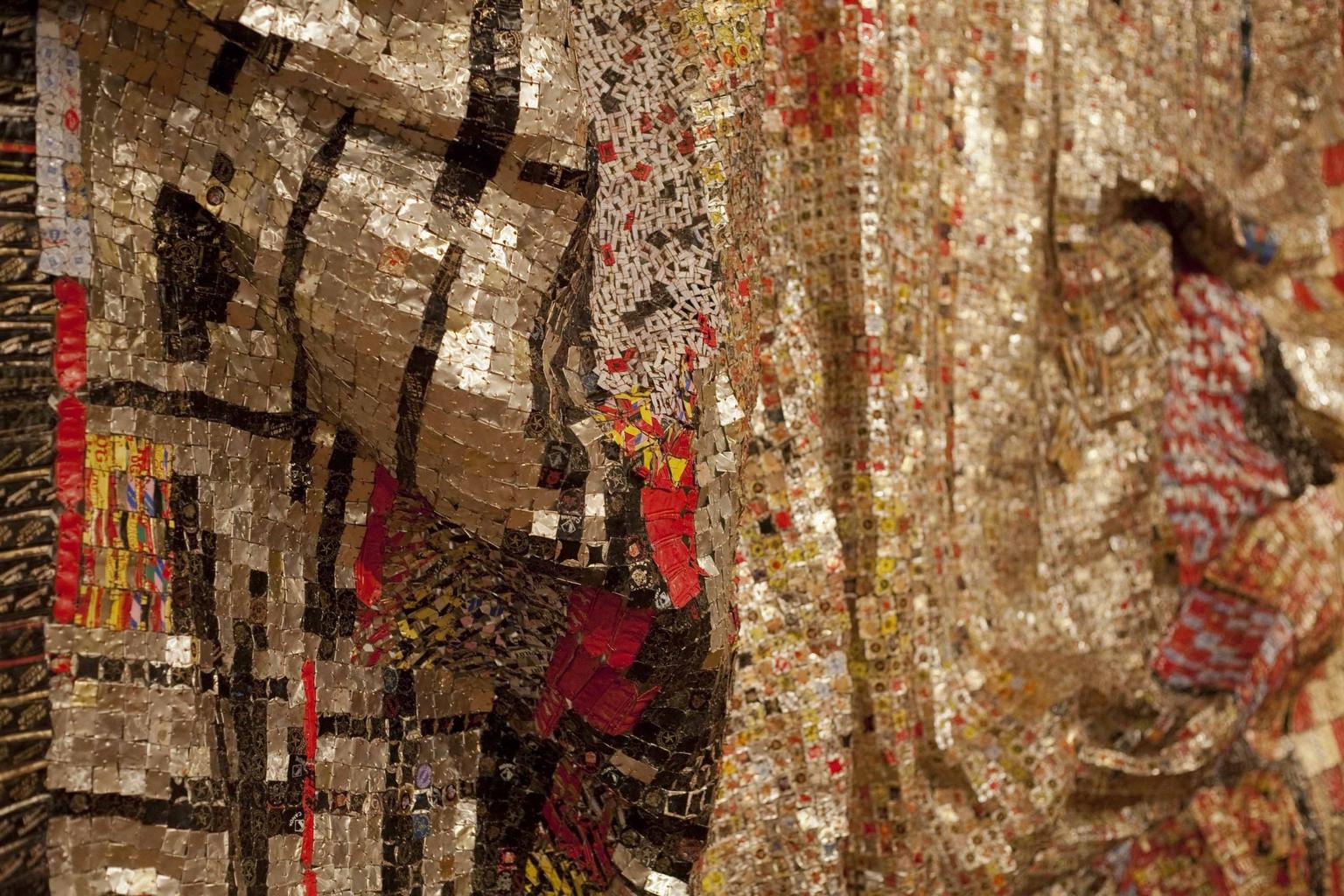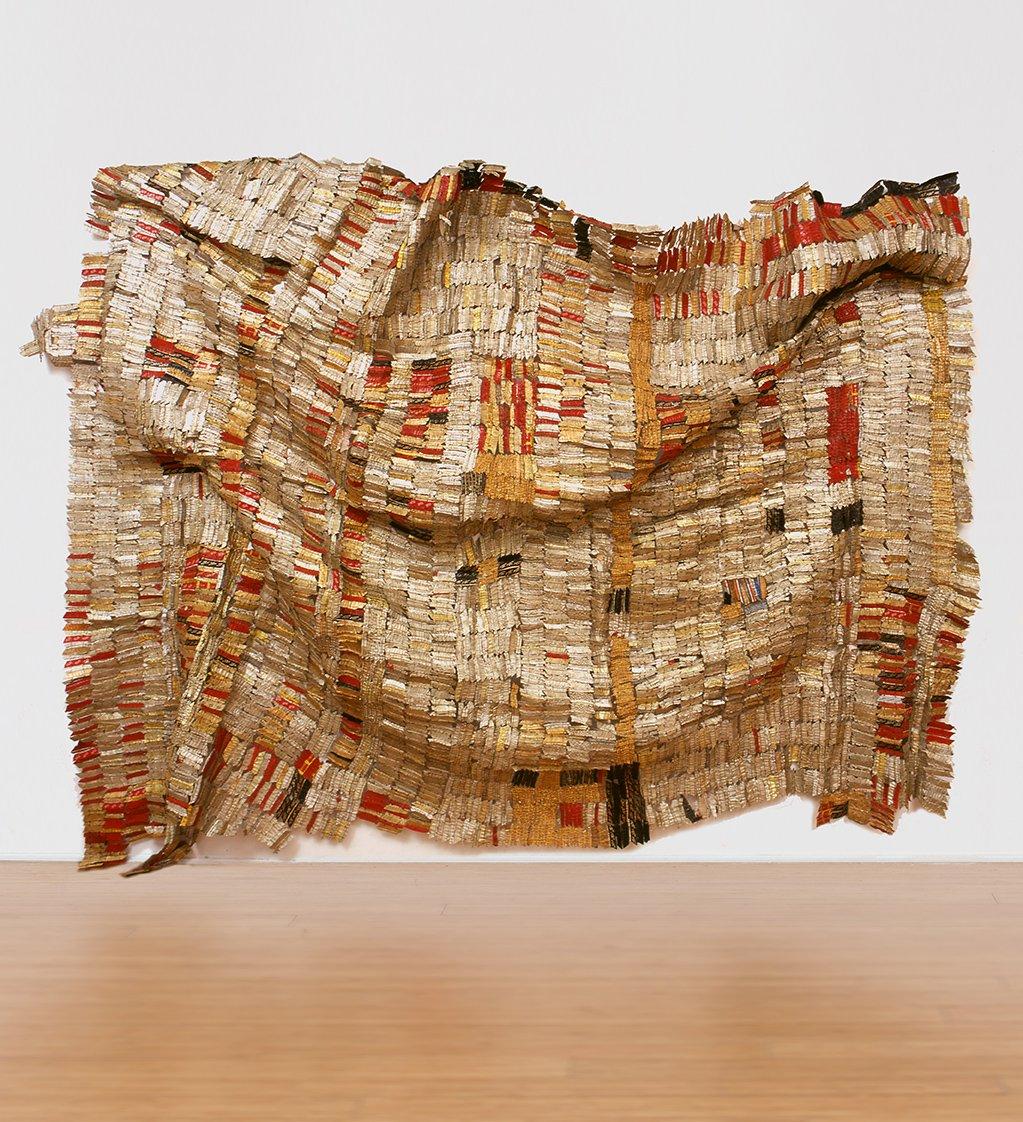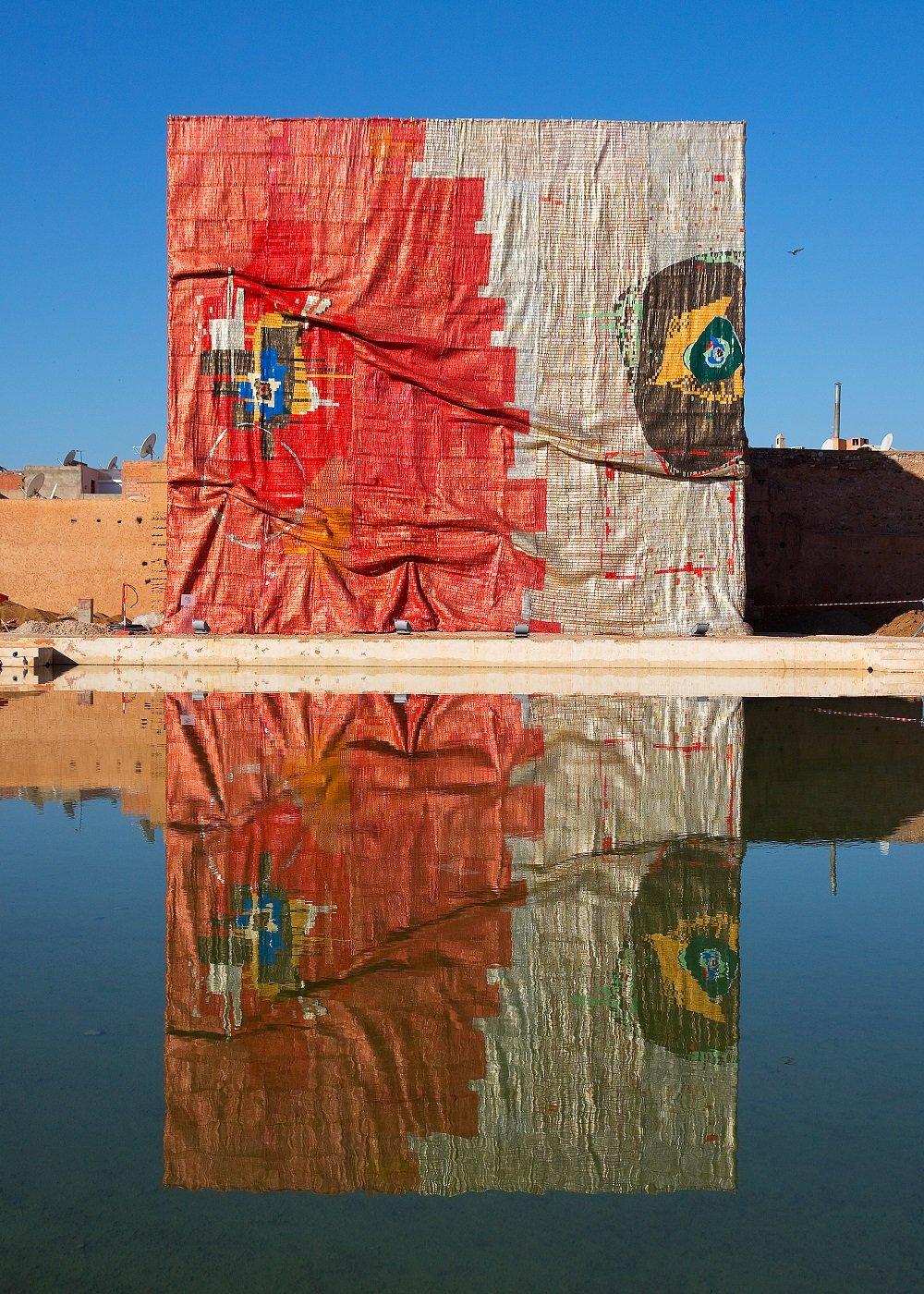El Anatsui: ‘Ideas and creativity are not restricted to any one place‘

El Anatsui's works let the complex history of reclaimed objects shine. The artist discusses his Tate Modern commission and more with Ellen Mara De Wachter.
A version of this article first appeared in the autumn 2023 issue of Art Quarterly, the magazine of Art Fund.
Who is El Anatsui?
Born in Ghana, in 1944, El Anatsui studied sculpture and taught art in Ghana before relocating to Nigeria in 1975, where he lectured at the University of Nigeria, Nsukka, for more than four decades. In his own practice, Anatsui has long worked with found materials including wooden food trays and mortars (the pounding bowls used with pestles), cassava graters and, since the late 1990s, reclaimed bottle caps. These he connects, in their thousands, with wire to create dazzling, large-scale draped and folded, cloth-like hangings and installations.
During the summer of 2013 his monumental work TSIATSIA – Searching for Connection graced the façade of London’s Royal Academy of Arts and, having received the Golden Lion for Lifetime Achievement at the 2015 Venice Biennale, in 2019 his work was the centrepiece of the inaugural Ghana Pavilion at Venice. Anatsui is the Emeritus Professor of Sculpture at Nsukka, while his contributions to his local community were recognised in 2019 when he was honoured with the chieftancy title Ikedire of Ihe-Nsukka kingdom. His new, site-specific commission for Tate Modern’s Turbine Hall opened to the public in October.
Ellen Mara De Wachter: You were interested in art from a young age, and you studied sculpture at Kwame Nkrumah University of Science and Technology in Kumasi, Ghana. Can you tell me about your art education during the 1960s?
El Anatsui: My school was modelled along the lines of a British art school and the curriculum was therefore wholly Western. We were learning about European art history, a little bit about Far Eastern art, and nothing about African art. It was like we were estranged from our culture. We questioned whether we had any art, and, if we had, why it wasn’t taught.
I used to go to the Centre for National Culture, in Kumasi, to explore Ghana’s art heritage, and I ‘discovered’ this elaborate collection of Adinkra pictograms, which had been used for many, many years, long before colonisation. I grew up in a part of Ghana where such things weren’t available, but here I was, looking at these Adinkra symbols, and each one had a name and meaning. At the time, we had just finished learning about the European Renaissance – about Paolo Uccello and the rest, and the way they were trying to look at the world through the eye.
But these Adinkra signs were trying to look at the world through the mind. They were also abstract. My introduction to art abstraction emerged from this time. It showed me where to go with my art, which is not about what things look like, but what meanings things can have. One Adinkra symbol is the Nkyinkyim, which I interpret as ‘versatility’. I believe my work has taken its cue from that and worked towards a form that doesn’t say only one thing but, if you manipulate it, is capable of saying many other things.
EMDW: After Ghana’s independence from British colonial rule, in 1957, there was a wide movement to regain a sense of African cultural heritage. How did this Sankofa movement influence your thinking and your art?
EA: During the time I was in art school, Ghana had only existed as an independent nation for a couple of years. What the colonial project achieved in so many parts of the world was to denigrate the cultures it met and impose the culture of the colonising country, since this made administration and economic exploitation easier.
So, colonial subjects were discouraged or prevented from doing things their own way, irrespective of their utility or validity, and forced to conform to the practices of the coloniser. That coloniser, as ruler, is seemingly gone today. Naturally, some colonised people wish to return to what they knew had worked for them, and it means seeing how this knowledge can be retrieved. ‘Sankofa’, in the Ghanaian language of Akan, means ‘to go back and retrieve something lost’. It’s an attitude prevalent when I was an art student – trying to find and retain one’s identity to develop it further. This Ghanaian identity had been erased by the colonial project, and needed to be restored and reimagined.
Used objects are more imbued with a story, which, at times, guides what you do with them
EMDW: From early on, you experimented with using readily available everyday objects for your art, rather than traditional art materials. How did you come to do this?
EA: In art school we were using materials that had nothing to do with our immediate environment, like imported plaster of Paris. When I started thinking about what to do, I thought, ‘OK, you have to find something which is available.’ In those days, as a young man, I often shopped in the local market. It was there I discovered the round wooden trays, which the market women used to display their wares: tomatoes, fish, onions. We hadn’t used wood much in school, so, I said to myself: ‘Why don’t you do something with wood?’
I used a very low-tech process of putting iron rods in a charcoal fire and branding the wood trays. The Adinkra pictograms that I was learning about came in handy as symbols to inscribe with the hot iron rods on these wooden trays. So, that was the beginning. After that, I worked with pots and with the idea of the broken pot. And from that, I worked with metal materials, starting with milk tin lids, and then cassava graters. And eventually, the bottle caps.
EMDW: What is it about used, damaged or discarded materials such as these that you find so compelling?
EA: I discovered that used objects are more imbued with a story, which, at times, guides you as to what to do with them. I started using objects like discarded food mortars, windows and doors. And I found that, with them, a large chunk of the story you want to tell has already begun, or even completed.
Used materials encourage contemplation about the history, or the anecdotal story of the material in question. The food mortars, for example, are discarded and not given any specific attention; they’re thrown away and left to the vagaries of the weather and whatever could attack them.
When I collect such discarded items, I want to give them a new lease of life in which they are no longer objects of utility, but works which you view at your leisure, and that may invite you to think about their journeys, and possibly your own. I present them standing up, to symbolise their resurrection. When we are in a spiritually uplifted position, the next direction is, hopefully, further towards heaven. My background is Christian, so I tend to consider a variety of options which can be taken.
EMDW: In the late 1990s you first began working used bottle caps. Why is this material so important to you?
EA: I use materials that emerge at the right time for me to become attracted to them. When it comes to the bottle caps, I go back to their history. How did these bottle caps arrive in Africa, and in my environment? They were brought by European traders who came with goods, including liquors, to trade by barter.
Then you think about the things that they exchanged these goods for, which included human beings transported to the Americas to work mainly on plantations, which generally produced sugar cane used in making alcoholic drinks, such as rum, which were sent to Africa, in a triangular intercontinental trade. European liquor not only linked the three continents and their cultures, it was used as currency in the African trade.
The bottle caps I use in my work are from drinks made in Africa for Africans since independence. Though no longer of European manufacture, their rich and troubling histories, legacies and journeys in a way come full circle with the bottle caps finding their way to Tate Modern.
When Ghana was a colony called the Gold Coast, much of the sugar we consumed was Tate & Lyle. Tate & Lyle might not have taken part in the transatlantic slave trade, but it benefited from the infrastructure and economic legacies of industrial slavery, like so many other industries and institutions in Britain today. Moreover, Tate & Lyle’s sugar was the primary ingredient for the production of rum and other liquors that anticipated the post-independence brands out of whose products my metal sculptures are made.

EMDW: In 2002 the British Museum acquired Man’s Cloth (2001) and Woman’s Cloth (2002). What did that acquisition mean to you?
EA: Museums acquire objects which they think add some value to them. That the British Museum acquired my works and paid for them, I think, marks a time of watershed, whereby museums are now paying to acquire work produced in nations where hitherto they would have obtained them by force. That’s one way that I look at it.
But the British Museum is prestigious, and whether it’s full of things legitimately acquired or not, it’s a place people naturally have to visit, so if one’s work is in such a museum, it has the opportunity of people encountering it from so many other cultures. If one’s work is there, it is contributing in its own unique way to uniting the world through art. It is an agent for helping the world to understand that ideas and creativity are not restricted to any one place, but, like humanity, are distributed all over the Earth.
EMDW: How has your teaching career affected the way you create art, and does education continue to be part of your life?
EA: I still teach. Not by conducting a formal class, but instead students join my studio practice. I have many young people who work with me, and so I am constantly teaching as we work.
EMDW: Could you describe your studio and a typical working day there?
EA: I have two studios. One in Nigeria, at Nsukka, where I was for close to 47 years, and I think most of my practice developed there. On a good day there could be 60 people at work. Working with little elements like bottle caps, if I’m going to do a lot of manipulation and joining, in order to get a good speed of realising things I need plenty of hands. There are maybe 20 regular people who have worked with me for more than 14 years. The second studio is in the harbour city of Tema, in Ghana. It is fairly new; this is about the second year. There are about 10 people assisting me, and two artists who help to supervise and direct work.
EMDW: That sounds like a community?
EA: You know, I started thinking that, as an artist, you have to be the one doing everything, it has to be your hands doing everything. But looking at the model provided by architecture, for instance, I found that you do not have to do everything beyond generating the idea. The architect does the drawings and other people then take over. That kind of thinking crept in when I started working with the bottle caps and other smaller pieces which needed group labour. I discovered, after a couple of years working with a large group of people, that there is energy in numbers. The work is repetitive, but each person has a personal touch, so it’s not like machine repetition but repetition which has all the human flaws and nuances. As an artist you are conducting an orchestra of many people and you have to create a way of coordinating the seeming difference and the key properties that the individual ‘hands’ bring to the work.

EMDW: Your work has previously been linked to environmental sustainability. Has this been a goal of your work, or is it a positive by-product?
EA: I think it is more of a positive by-product, but I have tried to think about the environment in relation to the international transportation of large works, which can have a huge carbon footprint on our environment. I have consciously thought about how not to create such works and therefore most of my work aims at something that is light, easy to pack and occupies very little space while being transported. Working in this way made me think that what I was doing was a nomadic aesthetic. Nomads move with things they can easily carry, and when they get to a destination they set up their tents and continue to live their lives.
EMDW: How are you thinking about your art in relation to the architecture of the Turbine Hall?
EA: When I was approached for this project, the first thought was Tate & Lyle sugar. Normally artists would want their work to relate to the space they’re working with and consider specific events and associated histories. It’s like going to the archives of the space. That was how thoughts about the bottle caps and the relationship to slavery and sugar re-emerged. The Turbine Hall is post-industrial architecture, and I want my work to reflect on the notion of industry, whether by humans or through their use of machines. The artworks created by hand from machine-manufactured bottle caps support both these notions of ‘manufacture’ (originally, making by hand) and ‘industry’.
‘Hyundai Commission: El Anatsui’, Tate Modern, London, 10 October to 14 April 2024, 50% off paid exhibitions with National Art Pass.